

The 12 Common Archetypes. The 12 Common Archetypes By Carl Golden The term "archetype" has its origins in ancient Greek.
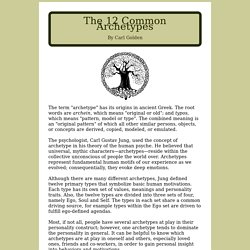
The root words are archein, which means "original or old"; and typos, which means "pattern, model or type". The combined meaning is an "original pattern" of which all other similar persons, objects, or concepts are derived, copied, modeled, or emulated. The psychologist, Carl Gustav Jung, used the concept of archetype in his theory of the human psyche. Although there are many different archetypes, Jung defined twelve primary types that symbolize basic human motivations. Most, if not all, people have several archetypes at play in their personality construct; however, one archetype tends to dominate the personality in general. Return Home. Carl Jung: Sea of Faith [FULL DOCUMENTARY] Jung on Film [FULL INTERVIEW] Essay- archetype of wholeness. Jung's Archetypes. Explanations > Identity > Jung's Archetypes The Shadow | The Anima | The Self | Other archetypes | Deep origins | See also Psychologist Carl Gustav Jung described several archetypes that are based in the observation of differing but repeating patterns of thought and action that re-appear time and again across people, countries and continents.
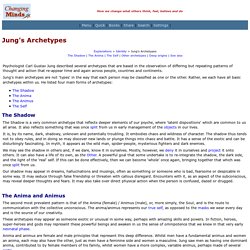
Jung's main archetypes are not 'types' in the way that each person may be classified as one or the other. Rather, we each have all basic archetypes within us. He listed four main forms of archetypes: The Shadow The Shadow is a very common archetype that reflects deeper elements of our psyche, where 'latent dispositions' which are common to us all arise. It is, by its name, dark, shadowy, unknown and potentially troubling. We may see the shadow in others and, if we dare, know it in ourselves. Our shadow may appear in dreams, hallucinations and musings, often as something or someone who is bad, fearsome or despicable in some way. Archetypes & The Individuation Process. Following the lead of the master I'll take a somewhat circuitous route to the concept of individuation.
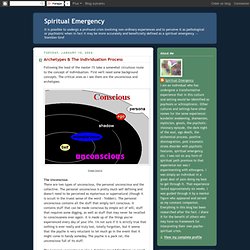
First we'll need some background concepts. The critical ones as I see them are the unconscious and archetypes. Image Source The UnconsciousThere are two types of unconscious, the personal unconscious and the collective. The personal unconscious is pretty much self defining and doesn't need to be perceived as mysterious or supernatural (though it is occult in the truest sense of the word - 'hidden').
The personal unconscious is also a dumping ground for things we aren't comfortable with and which we'd really rather not have in consciousness very often. Another interesting aspect of the personal unconscious is that recall can be influenced by context. The collective unconscious likewise is pretty much self defining. ArchetypesArchetypes are essentially quasi autonomous functions which give rise to specific motifs, as common in all mythology as in any individual's life. See also: The Major Archetypes. The HeroThe word hero is Greek, from a root that means "to protect and to serve".

A Hero is someone who is willing to sacrifice his own needs on behalf of others, like a shepherd who will sacrifice to protect and serve his flock. Myths-Dreams-Symbols-Shadow. The first step is taken towards self-realization {individuation} when you meet your 'shadow'.
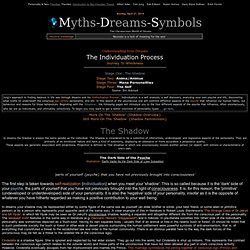
This is so called because it is the 'dark' side of your psyche, the parts of yourself that you have not previously brought into the light of consciousness. It is, for this reason, the 'primitive' (undeveloped or underdeveloped) side of your personality. It is also the 'negative' side of your personality, insofar as it is the opposite of whatever you have hitherto regarded as making a positive contribution to your well being. In dreams your shadow may be represented either by some figure of the same sex as yourself (an elder brother or sister, your best friend, or some alien or primitive person) or by a person who represents your opposite (and of the same sex). Cinderella is a shadow figure. Volume 9.1: The Archetypes of the Collective Unconscious. Abstracts of the Collected Works of C.G.
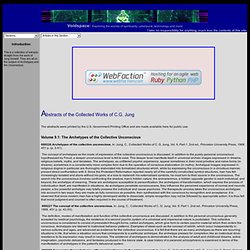
Jung The abstracts were printed by the U.S. Government Printing Office and are made available here for public use. The Individuation Process and the Artist. By Laura Strong, PhD Throughout his career, Carl Gustav Jung was driven by a deep desire to understand the relationship between the conscious mind and the vast realms of the unconscious.
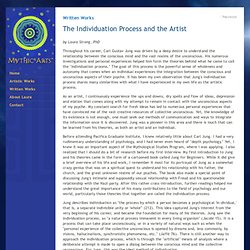
His numerous investigations and personal experiences helped him form the theories behind what he came to call the "individuation process. " The goal of this process is the powerful sense of wholeness and autonomy that comes when an individual experiences the integration between the conscious and unconscious aspects of their psyche. It has been my own observation that Jung's individuation process shares many similarities with what I have experienced in my own life as the artistic process. As an artist, I continuously experience the ups and downs, dry spells and flow of ideas, depression and elation that comes along with my attempt to remain in contact with the unconscious aspects of my psyche.
Before attending Pacifica Graduate Institute, I knew relatively little about Carl Jung. Works Cited Grey, Alex. Jungian Maps.
The Anima and Animus.